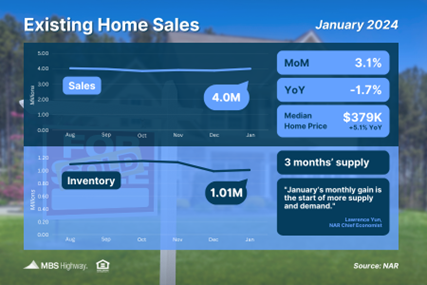-
- 28 FEB

Week of February 19, 2024 in Review
Closings on existing homes picked up last month, while recent commentary shows that Fed members remain cautious about cutting rates too soon. Read on for these stories and more:
• Existing Home Sales Rebound in January
• Fed in No Hurry to Cut Rates
• Recession Forecast Softened
Existing Home Sales Rebound in January
Existing Home Sales rose 3.1% from December to January to a 4-million-unit annualized pace, with December’s sales also revised higher per the National Association of REALTORS® (NAR). When compared to January 2023, sales were down 1.7%.
What’s the bottom line? This report measures closings on existing homes in January and likely reflects people shopping for homes in November and December, when rates backed off from their peak. NAR’s Chief Economist, Lawrence Yun, added that “listings were modestly higher, and home buyers are taking advantage of lower mortgage rates compared to late last year.”
Any increase in listings is a positive sign for much needed supply. There were just 1.01 million homes available for sale at the end of January, which is below healthy levels at just a 3 months’ supply of homes at the current sales pace. Meanwhile, demand for homes remains strong, with Yun adding that “multiple offers are common on mid-priced homes, and many homes were still sold within a month.”
Fed in No Hurry to Cut Rates
The minutes from the Fed’s January meeting showed that members were generally optimistic that their policy moves had succeeded in lowering inflation. Members also felt they had reached their peak Fed Funds Rate for this cycle.
The Fed Funds Rate is the interest rate for overnight borrowing for banks and it is not the same as mortgage rates. The Fed’s eleven hikes between March 2022 and July 2023 were made to slow the economy and curb the runaway inflation seen over the last few years.
What’s the bottom line? Fed members want to see more data before they ease monetary policy, and they don’t expect to begin cutting rates until they have “gained greater confidence that inflation is moving sustainably toward 2 percent.” This cautious approach from January’s meeting has been echoed more recently by several Fed members, including Philadelphia Fed President Patrick Harker and Fed Governor Christopher Waller. The more “sticky” these inflation numbers the further out in time Fed rate cuts are pushed, and fewer cuts will be likely.
Recession Forecast Softened
The Conference Board released their latest Leading Economic Index (LEI), which is a forward-looking index that takes a broad look at the economy and tracks where it’s heading in the near term. January brought a 0.4% drop, marking the 22nd consecutive month of declines. The last time the index fell 22 straight months was in 2007 to 2009, during the global financial crisis.
What’s the bottom line? Despite January’s decline, the Conference Board softened their tone on recession expectations. Justyna Zabinska-La Monica, Senior Manager, Business Cycle Indicators, explained, “While the declining LEI continues to signal headwinds to economic activity, for the first time in the past two years, six out of its ten components were positive contributors over the past six-month period (ending in January 2024). As a result, the leading index currently does not signal recession ahead.”
What to Look for This Week
The latest New and Pending Home Sales reports will give us an update on signed contracts for January when they’re released on Monday and Thursday, respectively. We’ll also get appreciation data for December from Case-Shiller and the Federal Housing Finance Agency on Tuesday.
Look for the second reading for fourth quarter 2023 GDP on Wednesday, while Thursday brings the latest Jobless Claims and likely the biggest news of the week via the Fed’s favored inflation measure, Personal Consumption Expenditures.
